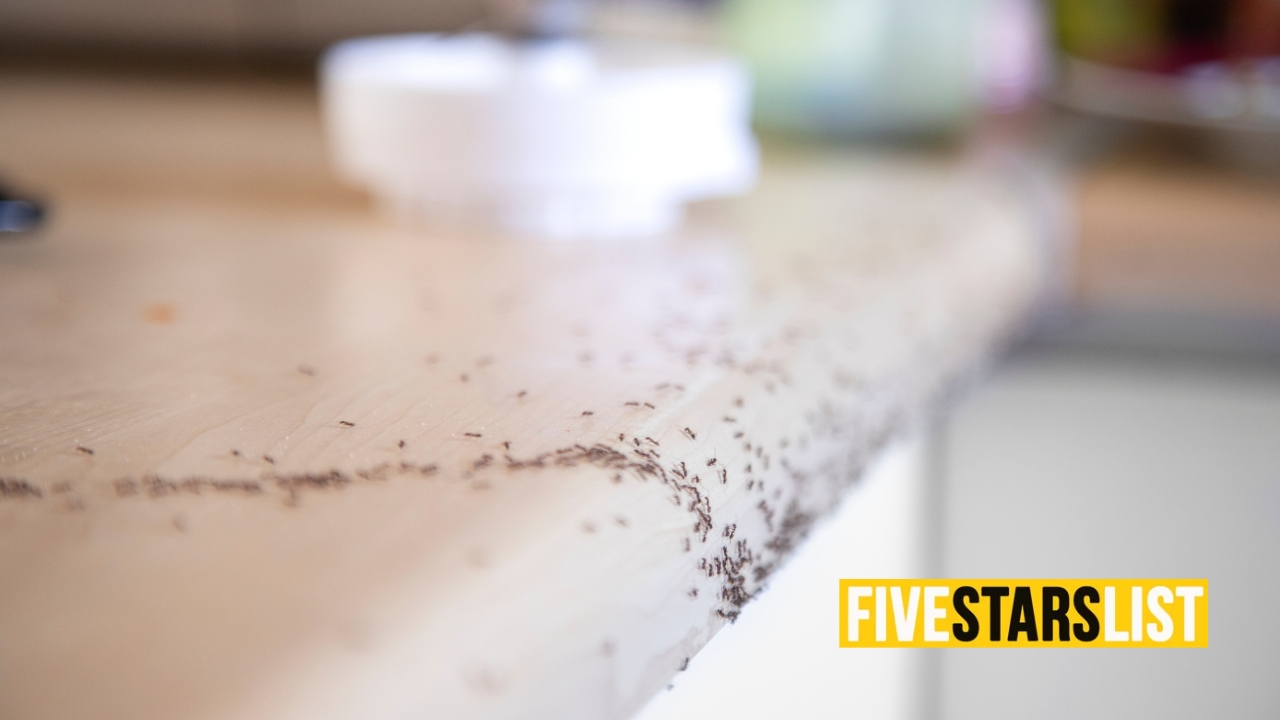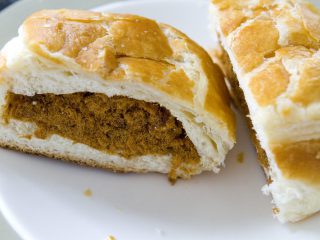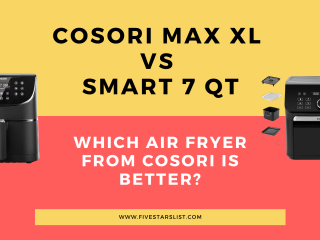As an Amazon Associate I earn from qualifying purchases.

Graphic by fivestarslist.com
We know how frustrating it is to deal with ants. Getting rid of ants in the kitchen involves identifying their entry points, removing food sources, and using effective ant control methods. With the right approach, we can reclaim our kitchens from these pesky invaders.
Let’s explore some practical ways to tackle this common household problem. We’ll share tips on prevention, natural remedies, and when to call in the pros. By following these steps, we can keep our kitchens ant-free and enjoyable spaces for cooking and gathering.
Understanding Ant Behavior

Ants are clever insects that work together in large groups. They follow set paths and communicate in unique ways. This helps them find food and build nests in our kitchens.
Identifying Common Types of Kitchen Ants
We often see several kinds of ants in kitchens. House ants are small and black. They love sugary foods. Pharaoh ants are tiny and light yellow. These ants can spread germs.
Pavement ants are dark brown or black with pale legs. They enter through cracks in walls. Odorous house ants smell like rotten coconuts when crushed. They’re drawn to sweet and greasy foods.
Each type of ant has its own habits. Knowing which ants we’re dealing with helps us get rid of them better.
The Role of Pheromone Trails in Ant Infestations
Ants use special scents called pheromones to talk to each other. They leave these scents as trails when they find food. Other ants follow these trails to the food source.
Pheromone trails act like ant highways. Ants can quickly bring lots of workers to a food spot using these trails. The more ants use a trail, the stronger it gets.
To stop ants, we need to break these trails. Cleaning up food spills and wiping surfaces with vinegar can help. This makes it harder for ants to find their way back to food sources in our kitchens.
Preventative Measures to Discourage Ants
We can take several steps to keep ants out of our kitchens. By storing food properly, sealing entry points, and cleaning regularly, we’ll make our homes less inviting to these tiny invaders.
Store Food in Airtight Containers
Ants are drawn to easy food sources. We need to keep our food in sealed containers to stop them. Glass jars, plastic bins with tight lids, and zip-top bags work well. This is key for sweet foods like sugar, honey, and syrup.
Don’t forget about pet food. It can attract ants too. Keep it in a sealed bin when not in use.
Even fruit should be stored in the fridge or in containers. Ants love ripe fruit left out on counters.
Seal Entry Points to Deter Intruders
Ants can squeeze through tiny gaps. We need to find and seal these openings. Check around windows, doors, and pipes. Look for small cracks in walls or floors.
Use caulk to fill in cracks and gaps. Weather stripping can help seal doors and windows. Steel wool works well for larger holes.
Don’t forget about outdoor entry points. Trim trees and bushes that touch the house. Ants can use these as bridges to get inside.
Regular Cleaning Regimen to Avoid Attraction
A clean kitchen is less likely to attract ants. We should wipe down counters and tables after every meal. Sweep or vacuum floors daily to remove crumbs.
Clean up spills right away, especially sweet drinks. Don’t leave dirty dishes in the sink overnight.
Take out the trash often. Rinse recyclables before putting them in the bin.
Use vinegar and water to clean. This removes ant trails and food smells that might attract them.
Natural and Homemade Ant Deterrents
We can use many items from our kitchen to keep ants away. These natural options are safe and effective.
Using Vinegar and Lemon as Repellents
Vinegar and lemon are great for getting rid of ants. We can mix equal parts water and white vinegar in a spray bottle. This mixture wipes away ant trails and masks scents they follow.
Lemon juice works in a similar way. We can squeeze fresh lemon juice along entry points or wipe surfaces with lemon peels. The strong citrus smell confuses ants and keeps them away.
For best results, we should use these methods daily until the ants are gone.
Essential Oils for Ant Prevention
Essential oils are strong-smelling and natural ant deterrents. Peppermint oil is very effective. We can put a few drops on cotton balls and place them in problem areas.
Other useful oils include:
- Tea tree
- Citrus (lemon, orange)
- Eucalyptus
We can mix 15-20 drops of oil with water in a spray bottle. This makes a safe, nice-smelling ant repellent for our kitchen.
Kitchen Ingredients That Repel Ants
Many common kitchen items can keep ants away:
- Cinnamon: Sprinkle ground cinnamon or place cinnamon sticks near entry points.
- Coffee grounds: Spread used coffee grounds in garden areas or near doors.
- Spices: Cayenne pepper, black pepper, and cloves all repel ants.
We can make a paste with water and any of these items. Then, we apply it to areas where we’ve seen ants.
These methods are safe for homes with kids and pets. They also don’t leave harmful chemicals around our food prep areas.
Eradicating Ant Infestations
Getting rid of ants in the kitchen takes a mix of baits, traps, and sometimes stronger methods. We’ll look at DIY options and when to call the pros.
Using Baits and Traps to Eliminate Ants
Ant baits are a top choice for tackling ant problems. We place these small containers with sweet or protein-based poison where ants travel. The ants take the bait back to their nest, sharing it with others.
This method can wipe out the whole colony. It’s slow but very effective. Store-bought baits work well, but we can also make our own with borax and sugar.
Ant traps are another useful tool. These sticky devices catch ants as they walk over them. We put traps in corners, near cracks, and along ant trails.
For best results, we use a mix of baits and traps. It’s key to keep them out of reach of kids and pets.
Chemical Insecticides and Professional Extermination
When baits and traps aren’t enough, we might need stronger stuff. Insecticide sprays can kill ants on contact. We spray them around entry points and ant paths.
But be careful – some sprays are toxic. We always read labels and follow safety rules. It’s smart to avoid spraying near food or cooking areas.
For big ant problems, we might need to call an exterminator. These pros have strong chemicals and know how to use them safely. They can find and treat ant nests we can’t see.
Exterminators often use a mix of baits, sprays, and powders. They can also spot and fix things that attract ants to our kitchen.
Aftercare and Routine Inspection
Getting rid of ants is just the first step. We need to stay vigilant to prevent them from coming back. Let’s look at how to keep our kitchen ant-free long-term.
Monitoring for Recurrence and Sustained Prevention
We should check our kitchen regularly for signs of ants. Look in corners, under appliances, and near food storage areas. If we spot even a few ants, it’s time to act fast.
Keep using ant baits as a precaution. Place them in areas where we’ve seen ants before. This helps catch any stragglers before they can form a new colony.
We can make our own ant repellents too. A vinegar solution works well. Mix equal parts water and white vinegar in a spray bottle. Use it to wipe down counters and floors weekly.
For extra protection, sprinkle diatomaceous earth in entry points. This natural substance is safe for us but deadly for ants. Be sure to reapply after cleaning.
If pharaoh ants were our problem, we need to be extra careful. These tiny ants are tough to get rid of. We might need to use boric acid baits long-term to keep them away.
Remember, cleanliness is key. Wipe up spills right away and don’t leave food out. Store pantry items in airtight containers. This makes our kitchen less tempting to ants.
Image source: Amazon Product Advertising API
Amazon and the Amazon logo are trademarks of Amazon.com, Inc, or its affiliates.



